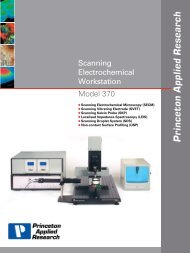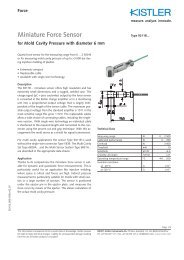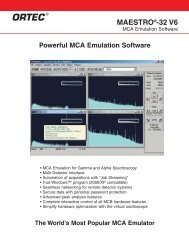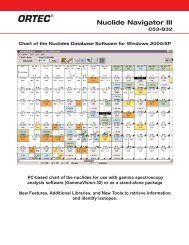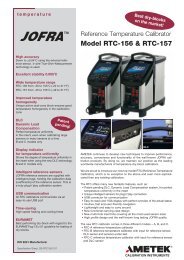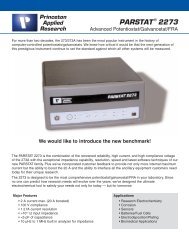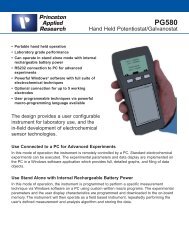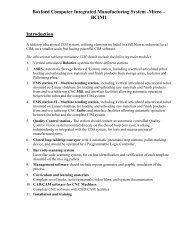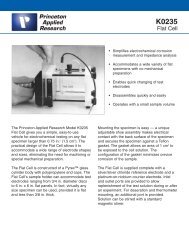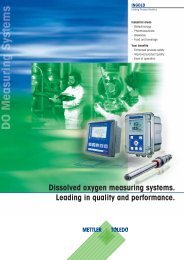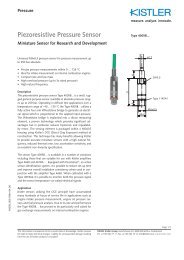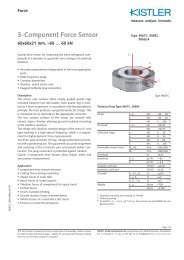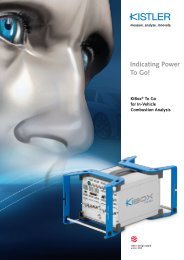Laboratory catalogue
Laboratory catalogue
Laboratory catalogue
Create successful ePaper yourself
Turn your PDF publications into a flip-book with our unique Google optimized e-Paper software.
milk does not meet this criterion. Then a second sample<br />
of the milk has to be measured. If this error suddenly<br />
starts to make a frequent appearance, although the<br />
device has otherwise been working properly, the problem<br />
lies either with the thermistor, or is the result of disturbance<br />
caused by external interference.<br />
Uncalibrated or defective thermistor:<br />
The device tests the actual thermistor value when commencing<br />
a measurement of calibration. As is well known,<br />
its electrical resistance is a function of the temperature.<br />
This electrical resistance is translated into a number by<br />
an analogue-digital converter (ADC) and this value is<br />
further processed by the device. Now if the thermistor<br />
has a short circuit or is interrupted, its resistance is zero<br />
or infinite, both of which conditions are impossible for a<br />
properly working thermistor. In this case, the thermistor<br />
will not commence with the measurement.<br />
The device will also fail to commence measuring if the<br />
actual thermistor value, together with the calibration<br />
constants stored in the device, produce a result that is<br />
lower than +1 °C (which cannot happen if the thermistor<br />
is positioned in a new, i.e. still warm, sample).<br />
Identifying operational errors<br />
Most of the errors that are made when using the device<br />
result from faulty calibrations. The calibration of a<br />
cryoscope is an essential condition for its use. For technical<br />
reasons relating to measurements, it is necessary<br />
to use a thermistor for measuring the temperature of the<br />
sample. Thermistors are sensitive to a wide range of<br />
temperatures and this sensitivity is necessary for a resolution<br />
of more than 1 m°K. Unfortunately, fluctuations<br />
in the resistance values of these components are so<br />
great that the zero temperature point (0 °C) usually has<br />
to be determined by pre-calibration before the device<br />
can be calibrated with a new thermistor.<br />
It must be assumed that an A-calibration cannot be performed<br />
successfully after a thermistor has been<br />
exchanged. The reason for this is that the device must<br />
first of all reach the set knocking temperature and then,<br />
after knocking, has to identify an increase in temperature<br />
(as an indication that freezing has begun). But this<br />
is not the case, because the new thermistor values<br />
result in the wrong temperatures being given when calculated<br />
according to the calibration constants of the old<br />
thermistor. This is why a so-called pre-calibration is necessary,<br />
in which the device ignores the temperatures<br />
and follows a purely time-controlled measuring procedure.<br />
After this, the calibration constants must be<br />
adapted to the new thermistor characteristics so that<br />
both the A-calibration and the B-calibration can be performed<br />
successfully.<br />
Unfortunately, it often so happens that sample flasks<br />
filled calibration solutions are mixed up, or that the<br />
wrong menu item is selected.<br />
Mix-up: confusing solution A with solution B:<br />
To begin with, the A-calibration goes as expected. But<br />
when it comes to the B-calibration, the device reports<br />
the error “uncalibrated or defective thermistor” and it<br />
remains in the uncalibrated state. With older versions of<br />
firmware, the device retains the wrong values and is<br />
henceforth not prepared to perform a measurement. It<br />
is advisable to carry out a new pre-calibration, followed<br />
by a proper calibration, in any case.<br />
Mix-up: taking the A-calibration instead<br />
of the B-calibration<br />
This results in the displacement of the entire temperature<br />
scale of the device. Re-measuring of the calibration<br />
solutions gives reversed values and a reversed sign. For<br />
example:<br />
Calibration A with 0.000<br />
Calibration A with 0.000<br />
Calibration B with –0.557<br />
Calibration A with –0.557 (faulty operation)<br />
Re-measuring solution B: results in 0.000<br />
Re-measuring solution A: results in 0.557<br />
Defective thermistor<br />
This is the most common source of errors. There are two<br />
possibilities here:<br />
1. The thermistor is (was) broken. This can be recognised<br />
because the display constantly shows a negative<br />
value that does not change.<br />
2. The thermistor bonding is porous. This results in<br />
extremely unstable measurements. The reproducibility<br />
is very poor, e.g. there are variations of about<br />
+0.1 °C.<br />
The thermistor must be exchanged in either case.<br />
63



